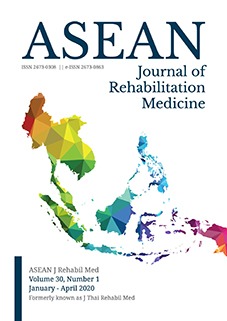The Effectiveness of Indoor Socks with Medial Arch Support in Decreasing Pain in Patients with Posterior Tibial Tendon Dysfunction: a Prospective, Double-blinded, Randomized Controlled Trial
Keywords:
posterior tibial tendon dysfunction, flat foot, medial arch support, foot painAbstract
Objective: To study the effectiveness in application of indoor socks with medial arch support on decreasing pain in patients with posterior tibial tendon dysfunction
Study design: Prospective, randomized single-blinded controlled trial
Setting: Foot clinic, Department of Rehabilitation Medicine, Faculty of Medicine Siriraj Hospital
Subject: Forty – two patients who had posterior tibial tendon dysfunction with foot pain were enrolled in the prospective, randomized single-blinded controlled trial at the Out - Patient Rehabilitation Medicine Clinic, Siriraj Hospital during August 2017 – August 2018
Methods: Patients were randomized into two groups, the study group (using socks with medial arch support) and the control group (using socks with flat foam). Patients in both groups were advised to wear them while walking and standing indoors for 2 weeks. The complication and duration of using socks with medial arch support or sham were recorded in a logbook. The pain score, as recorded by numeric rating scale, was asked before and after 2 weeks after using them.
Results: After using socks for 2 weeks, there were statistically significant decreases in foot pain in both the study group (p-value < 0.001) and in the control group (p-value = 0.004) compared to baseline. However, when comparing the differences in pre / post-intervention foot pain between two groups, there was no statistically significant difference (p-value = 0.07).
Conclusion: In patients with posterior tibial tendon dysfunction, using indoor socks with medial arch support showed no statistically significant difference in decreasing foot pain when compared to the control group.
References
Kohls-GatzoulisJ, Woods B, Angel JC, Singh D. The prevalence of symptomatic posterior tibialis tendon dysfunction in women over the age of 40 in England. Foot Ankle Surg. 2009;15:75-81.
Lee MS, Vanore JV, Thomas JL, Catanzariti AR, Kogler G,Kravitz SR, et al. Diagnosis and treatment of adult flatfoot. J Foot Ankle Surg. 2005;44:78-113.
Guelfi M, Pantalone A, Mirapeix RM, Vanni D, Usuelli FG, Salini V. Anatomy, pathophysiology and classification of posterior tibial tendon dysfunction. Eur Rev Med Pharmacol Sci. 2017;21:13-9.
Supple KM, Hanft JR, Murphy BJ, Janecki CJ, Kogler GF. Posterior tibial tendon dysfunction. Arthritis Rheum. 1992:22,106-13.
Masamitsu K, Kazuya I, Yusuke H, Kan I, Masahiro M, Takumi I, et al. Effect of therapeutic insoles on the medial longitudinal arch in patients with flatfoot deformity: a three-dimensional loading computed tomography study. Clin Biomech (Bristol, Avon). 2014; 29: 1095-8.
Yao K, Yang TX, Yew WP. Posterior tibialis tendon dysfunction: overview of evaluation and management. Orthopedics. 2015;38: 385-91.
Karimi MT, Fereshtehnejad N, Pool F. The impact of foot insole on the energy consumption of flat-footed individuals during walking. Foot Ankle Spec. 2013;6:21-6.
ThammawijayaA, Assawapalangchai S. The study of the effects of a custom-molded medial arch support made from silicone in patients with plantar fasciitis. J Thai Rehabil Med. 2013;23:87-93.
Chao W, Wapner KL, Lee TH, Adams J, Hecht PJ. Nonoperative management of posterior tibial tendon dysfunction. Foot Ankle Int. 1996;17:736-41.
ElftmanNW. Nonsurgical treatment of adult acquired flat foot deformity. Foot Ankle Clin. 2003;8:473–89.
Nielsen MD, Dodson EE, Shadrick DL,Catanzariti AR, Mendicino RW, Malay DS. Nonoperative care for the treatment of adult- acquired flatfoot deformity. J Foot Ankle Surg. 2011;50:311-4.
Kulig K, Reischl SF, Pomrantz AB, Burnfield JM, Mais-Requejo S, Thordarson DB, et al. Nonsurgical management of posterior tibial tendon dysfunction with orthoses and resistive exercise: a randomized controlled trial. Phys Ther. 2009;89:26–37.
Alvarez RG, Marini A, Schmitt C, Saltzman CL. Stage I and II posterior tibial tendon dysfunction treated by a structured non- operative management protocol: an orthosis and exercise program. Foot Ankle Int. 2006;27:2–8.






